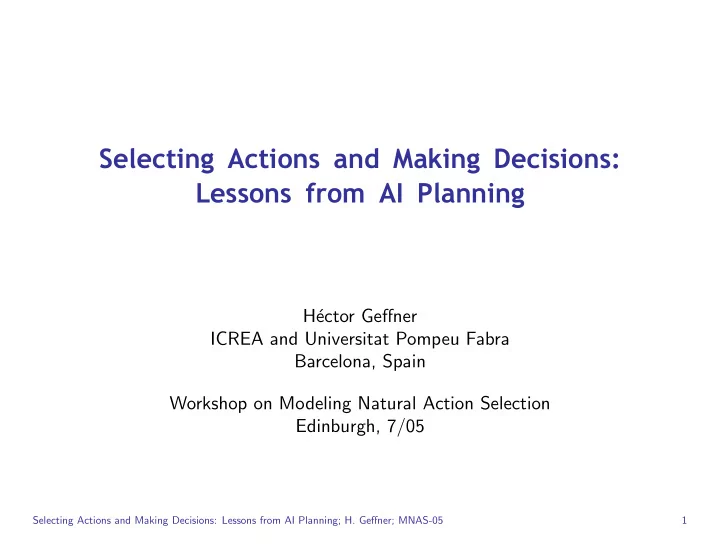

Selecting Actions and Making Decisions: Lessons from AI Planning H´ ector Geffner ICREA and Universitat Pompeu Fabra Barcelona, Spain Workshop on Modeling Natural Action Selection Edinburgh, 7/05 Selecting Actions and Making Decisions: Lessons from AI Planning; H. Geffner; MNAS-05 1
Motivation How are simple problems such as this solved by people? B C C D E E D B Start Goal • Work on the psychology has focused on problems that are hard for people ( puzzles ), yet . . . • Even simple problems are computationally hard for a general problem solver if it does not recognize and exploit structure Selecting Actions and Making Decisions: Lessons from AI Planning; H. Geffner; MNAS-05 2
Structure, Generality, and Complexity • A general problem solver must recognize and exploit structure in problems, otherwise computational complexity overwhelming • In last 10 years, work in AI Planning and Problem Solving has produced robust techniques for recognizing and exploiting structure that have been evaluted empirically • These techniques let a general problem solver adapt to the task at hand, and likely to be relevant for understanding how people find solutions to problems Selecting Actions and Making Decisions: Lessons from AI Planning; H. Geffner; MNAS-05 3
Techniques Some techniques for recognizing and exploiting structure in problems that proved robust experimentally are: • automatic extraction of heuristic functions from problems descriptions for guiding the search (heuristic function estimate cost to goal) • tractable inference for reducing the search, eliminating it completely in many cases • automatic transformation of representations so that certain hard inferences become computationally easy ( knowledge compilation ) Selecting Actions and Making Decisions: Lessons from AI Planning; H. Geffner; MNAS-05 4
Example: Automatic Derivation of Heuristic Functions • Assume a set of actions a characterized by preconditions, positive effects and negative effects, and costs • Computing optimal costs g ∗ ( p, s ) for achieving arbitrary atom p from state s intractable , yet can be efficiently approximated as: � 0 if p holds in s , else def g ( p ; s ) = min a : p ∈ add ( a ) [ cost ( a ) + g ( pre ( a ); s )] def r ∈ C g ( r ; s ) when C is a set of atoms where g ( C ; s ) = � • Distance to Goal from state s can then be approximated by heuristic function def h ( s ) = g ( Goal ; s ) and used for selecting actions; e.g., pick action that takes you closest to the goal. • Model related to P. Maes 1990 spreading activation model of action selection. Selecting Actions and Making Decisions: Lessons from AI Planning; H. Geffner; MNAS-05 5
Issues: Domain-generality vs domain-specificity • Domain-general mechanisms questioned by evolutionary psychologists and cognitive scientists from the fast and frugal heuristics school • Yet on the one hand, domain-specificity brings own problems : how many domains, what are the borders, how modules selected, . . . • On the other hand, the recent work in AI shows that general and adapted not necessarily in conflict; key is recognition and exploitation of structure • E.g., heuristics above are fast and frugal (i.e., linear-time ) but also general ; their form resulting from the actions in the domain • There is no question, however, that key features built-in by evolution in the DNA (E. Baum 1994) Selecting Actions and Making Decisions: Lessons from AI Planning; H. Geffner; MNAS-05 6
Issues: Solutions: Representation, Search, Execution • Solutions of many models, such as those involving uncertainty and feedback , are functions ( policies ) mapping states into actions • These functions can be represented in many ways (e.g., as condition-action rules, value functions, etc), and can be obtained in many ways as well; e.g, policies can be – computed automatically from problem representations in AI Planning – written-by-hand in suitable architecture in Behavior-based AI – hardwired-in-brains by process of evolution in Behavioral Ecology • Representing and executing solutions, however, while challenging, is different than coming up with the solutions in the first place which is what AI Planning is about. • Whether this is a requirement of intelligent behavior in animals is not clear although it seems to be a distinctive feature of intelligent behavior in humans. Selecting Actions and Making Decisions: Lessons from AI Planning; H. Geffner; MNAS-05 7
Emotions • Emotions no longer viewed as obstacle for good decision making, but rather as aid (Damasio 1994): “let emotions be our guide” (Ketelaar and Todd 2001) “emotions help humans solve the search problem” (D Evans 2002) • Emotions apparently summarize vasts amounts of information (beliefs, preferences, costs, etc). • The key computational question is how emotions accomplish these appraisals in real-time . • AI can help here as well; e.g., – Work on theory compilation (Darwiche 1990) suggests how similar appraisals can be done in linear-time over compiled representation ; while – Work on the automatic extraction of heuristics suggests how numbers approximating cost information can be computed in linear-time as well Selecting Actions and Making Decisions: Lessons from AI Planning; H. Geffner; MNAS-05 8
Summary • Balancing generality and efficiency is a key concern in agent design • Both goals attainable if structure of problems recognized and exploited • Recent work in AI shows this is possible and how: – automatic extraction of heuristics for guiding search – tractable inference for eliminating search in many cases, – theory compilation for speeding up inferences • Ideas underlying these techniques likely to be relevant for understanding human problem solving, and computational basis of emotions • Exploitation of structure also central in E Baum’s What is Thought , MIT Press 2004, but in context of evolution ; both views however are complementary Selecting Actions and Making Decisions: Lessons from AI Planning; H. Geffner; MNAS-05 9
Recommend
More recommend